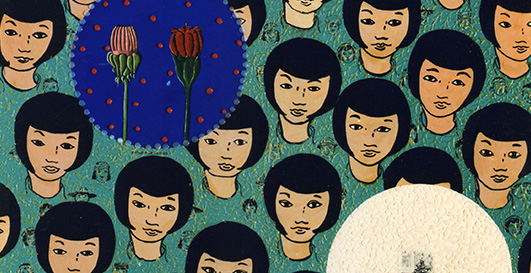La Nación Newspaper, 1999
Decorativism and humor
Carolina Antoniadis, an artist linked to neo-decorativism, had her first individual exhibition in 1987, at the age of twenty six. She had recently graduated from the Escuela Nacional de Bellas Artes (Fine Arts National School).
That same year, Antoniadis formed part of the Group of the X together with Jorge Macchi, Juan Paparella, Ernesto Ballesteros, Pablo Siquier. These young artists, who are now enjoying an increasing fame, shared an esthetical project opposed to that of the neo-expressionists, who were all ready well-known. Among the main features of their works are the recovery of some of the characteristics of concept art, abstract or cold and distant figurative painting, references to kitsch and mass communication media, decorativism, irony and humor. Decoration was one of the main enemies of avant-garde art, which sought functionality of ideas and contents. The artists of the first decades of the century (Mondrian, Malevich, the Bauhaus) believed what was decorative to be “lacking in sense” and merely ludic. Once it was said that ornamentation was a crime. For present art, however, it was one of the expressions of the return to spontaneous and de-ideologised painting, after the empire of concept art.
Neo-decorativism is an esthetic that, over anything else, works on the basis of the idea of the pleasure of painting and of the pleasure of watching. In this context, Antoniadis’ work meets these requirements in a complete and original manner.
Since the very early stages, her pictures showed a lot of humor and a remarkable optimistic atmosphere.
During the eighties, Antoniadis painted domestic interiors with walls decorated with flower printed wallpapers; printed fabrics cover furniture and spaces of the environment. Sometimes, when the motif is the atelier, she used the trick of painting a picture within the picture. In all these works, there are evident quotations of Bonnard, a painter who one century before had learned the value of what is decorative from Gauguin and the Japanese engravers.
Several thematic series painted throughout various years are shown at the MNBA (FINE ARTS NATIONAL MUSEUM). The motif of one of them is wedding cakes of several floors and twee ornamentation.
Other pictures represent decorative friezes with antique jars and backgrounds taken from Roman mosaics. There is also an allusion to patchwork – a feminine handicraft – in paintings of a repetitive geometrical structure.
Clothes and fashion are fundamental themes in Antoniadis’ Works. A white wedding dress with lace appears in a picture called La novia de azúcar (“The Sugar Bride”). The ironic reference to the wedding cake is evident. Japanese kimonos of an eatable appearance and underclothes decorated with women’s interior organs are other representations full of humor. The sociological and critical references in these paintings are notorious.
Carolina Antoniadis’ painting has a powerful sensual attractive with its baroque quality and its excesses in forms and colors.
Evidently, the paintings shown would horrify functionalists who supported the need of banishing everything that was superfluous.

Por Jorge López Anaya
